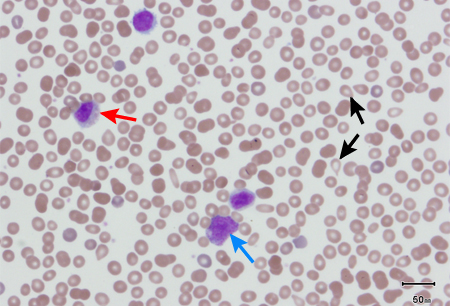Summary
Definition
Anamnesis y examen
Principales factores de diagnóstico
- history of radiation exposure
- history of industrial solvents exposure
- symptoms of anemia (fatigue, weakness, dyspnea, palpitations)
- constitutional symptoms (weight loss, night sweats, low-grade fever, cachexia, fatigue, and pruritus)
- splenomegaly ± hepatomegaly
- features of extramedullary hematopoiesis
Otros factores de diagnóstico
- features of portal hypertension
- joint and bone pain
- hearing loss
- bleeding
- infections
Factores de riesgo
- radiation exposure
- industrial solvents exposure
- age ≥65 years
- cytogenetic abnormalities
Pruebas diagnósticas
Primeras pruebas diagnósticas para solicitar
- CBC with differential
- peripheral blood smear
- bone marrow aspiration
- bone marrow biopsy
- fluorescence in situ hybridization (FISH) or multiplex reverse transcriptase PCR
- genetic mutation analysis
Pruebas diagnósticas que deben considerarse
- bone marrow cytogenetic analysis
- echocardiogram
- ultrasound of suspected site
- technetium 99 scan
- CT of suspected site
- MRI of suspected site
- serum uric acid
- antinuclear antibodies
- rheumatoid factor titer
- complement levels
- Coombs test
Algoritmo de tratamiento
lower risk: asymptomatic
lower risk: symptomatic
higher risk: younger stem cell transplant candidate without comorbidities
higher risk: stem cell transplant candidate >70 years or younger stem cell transplant candidate with comorbidities
higher risk: not stem cell transplant candidate
Colaboradores
Autores
Jerry L. Spivak, MD

Professor of Medicine and Oncology
Division of Hematology
Johns Hopkins University School of Medicine
Baltimore
MD
Divulgaciones
JLS is an author of several references cited in this topic and has been reimbursed by GSK for a consultation.
Agradecimientos
Professor Jerry Spivak would like to gratefully acknowledge Dr Ashkan Emadi, a previous contributor to this topic.
Divulgaciones
AE declares that he has no competing interests.
Revisores por pares
John T. Reilly, BSc, MD, FRCP, FRCPATH
Professor and Consultant in Haematology
Royal Hallamshire Hospital
Sheffield
UK
Divulgaciones
JTR is an author of several references cited in this topic.
Giovanni Barosi, MD
Director of the Laboratory of Clinical Epidemiology
IRCCS Policlinico S. Matteo Foundation
Pavia
Italy
Divulgaciones
GB declares that he has no competing interests.
Richard Silver, MD
Myeloproliferative Disorders Program Specialist
Department of Medicine
Division of Hematology and Medical Oncology
Weill Cornell Medical College
New York
NY
Divulgaciones
RS is an author of a reference cited in this topic.
Agradecimiento de los revisores por pares
Los temas de BMJ Best Practice se actualizan de forma continua de acuerdo con los desarrollos en la evidencia y en las guías. Los revisores por pares listados aquí han revisado el contenido al menos una vez durante la historia del tema.
Divulgaciones
Las afiliaciones y divulgaciones de los revisores por pares se refieren al momento de la revisión.
Referencias
Artículos principales
Tefferi A. Primary myelofibrosis: 2023 update on diagnosis, risk-stratification, and management. Am J Hematol. 2023 May;98(5):801-21.Texto completo Resumen
National Comprehensive Cancer Network. NCCN clinical practice guidelines in oncology: myeloproliferative neoplasms [internet publication].Texto completo
McLornan DP, Godfrey AL, Green A, et al. Diagnosis and evaluation of prognosis of myelofibrosis: a British Society for Haematology guideline. Br J Haematol. 2024 Jan;204(1):127-35.Texto completo Resumen
Kröger N, Bacigalupo A, Barbui T, et al. Indication and management of allogeneic haematopoietic stem-cell transplantation in myelofibrosis: updated recommendations by the EBMT/ELN International Working Group. Lancet Haematol. 2024 Jan;11(1):e62-74. Resumen
McLornan DP, Psaila B, Ewing J, et al. The management of myelofibrosis: a British Society for Haematology guideline. Br J Haematol. 2024 Jan;204(1):136-50.Texto completo Resumen
Artículos de referencia
Una lista completa de las fuentes a las que se hace referencia en este tema está disponible para los usuarios con acceso a todo BMJ Best Practice.

Diferenciales
- Polycythemia vera
- Essential thrombocythemia
- Chronic myeloid leukemia
Más Diferenciales指南
- NCCN clinical practice guidelines in oncology: myeloproliferative neoplasms
- NCCN clinical practice guidelines in oncology: hematopoietic cell transplantation (HCT)
Más 指南医学计算器
Dynamic International Prognostic Scoring System-Plus (DIPSS-Plus)
Mutation and Karyotype-Enhanced International Prognostic Scoring System for Primary Myelofibrosis in adults 70 and younger (MIPSS70+ version 2.0)
更多 医学计算器登录或订阅即可浏览 BMJ Best Practice 临床实践完整内容
内容使用需遵循免责声明